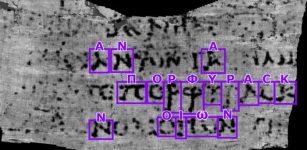Mysterious Shasu – Bandit Canaanites Or Israelites?
David Tee - AncientPages.com - When the Egyptians enshrined the name Shasu on the Merenptah war scenes at Karnak, they knew exactly whom they were talking about. After all, they were contemporaries. Now some approx. 33 centuries later, the identity of the Shasu is not well known.
Left: Pharaoh Merneptah's Canaanite battle reliefs in the Karnak Temple. Scene 8, Shasu captives. Credit: biblearchaeology.org Right: Shasu relief. Credit: Israel United Wiki
Some scholars have said that the Egyptians were talking about the Israelites who had recently conquered their Promised Land. Other scholars disagree mainly because those same war scenes present the Israelites as different people than the Shasu.
The different clothing is the first and foremost clue to the separate identities of the two peoples.
Who Were The Shasu?
Some scholars thought the Israelites were these bandits who roamed the countryside looking for easy prey. But with the different clothing used to depict each group of people, that theory cannot stand.
Part of the problem was that the Egyptians often grouped different ancient nations under one title. The Edomites, Ammonites, Moabites, Amalekites, Midianites, Kenites, and Hapiru as Shasu. This is not an exhaustive list.
The term shasu describes a group of people who did wander. This means that the Shasu may have been an independent society that sometimes moved about. Still, another ancient Egyptian word also referred to a certain geographical area of Canaan as the land of.
The Papyrus Anastasi I used the term Shasu to refer to a society of giants who happened to live in one corner of Canaan. Some scholars speculate that these giants were the ones the Israelites met during their Exodus to the Promised Land.
To Add To The Confusion
There are two Egyptian hieroglyphic mentions in the New Kingdom that contain the words- the land of the Shasu of Yahweh. The name Yahweh is strictly associated with the Hebrews. These references could mean that the Shasu, while not Hebrews, probably lived in the land of the Hebrews. It made them harder to identify.
It may also add to their nomadic lifestyle in that the Shasu moved wherever they found good grazing land or refuge from the Egyptian armies.
Were The Shasu Bandits?
It is highly possible that they were living on the wrong side of the law, especially since Egypt ruled most of the Levant at the time. In Egyptian eyes, the Shasu were common criminals meant to be rounded up, defeated, or executed.
The reason for this attitude was that the Shasu rarely let the Egyptians control them and sided with their enemies on numerous occasions. One such event was when the Hittites battled Rameses II.
One theory has it that the Egyptians considered the Shasu bandits because they gave these semi-nomadic people a name that meant plunderer. In other words, the Egyptians may have considered them bandits and given them an appropriate name.
It is also possible that the Shasu were trying to protect their land from the Egyptian conquerors. They used any means necessary, including being bandits.
The Limited Existence Of The Shasu
The term Shasu is mainly used in Egyptian military records and almost always from the New Kingdom era. This indicates that the Shasu enjoyed a limited existence as a nation. Or that the interaction between the Egyptians and the Shasu was not very extensive.
Egyptians beating Shasu spies. Detail from the Battle of Kadesh wall-carving. Credit: Public Domain
It is hard to say, as pastoral life is also tough to retrace archaeologically. James Hoffmeier, in his book Israel in Sinai, quotes Israel Finkelstein as saying that the nomadic life in the Levant is virtually invisible.
In other words, it is hard to find any trace of nomads using archaeological methods. David Hopkins echoes this conclusion in his article Pastoralists in Late Bronze Age Palestine: Which Way Did They Go?
What is known is that the Egyptians did depict their capture of the Shasu on different occasions in their monuments. One monument dates to the Old Kingdom, but scholars caution that the Old Kingdom is not very reliable for factual history.
This may have led to the short lifespan enjoyed by the Shasu people, who are often identified as Syro-Palestinian residents.
Whoever the Shasu were, they were certainly a thorn in the Egyptian's side for many decades. They probably used the bandit lifestyle to help them survive the harsh environments of the Sinai desert.
Updated on November 20, 2022
Written by – David Tee - AncientPages.com Staff Writer
Copyright © AncientPages.com All rights reserved. This material may not be published, broadcast, rewritten or redistributed in whole or part without the express written permission of AncientPages.com
Expand for referencesPastoralists in Late Bronze Age Palestine: Which Way Did They Go? By David Hopkins (2001). Biblical Archaeologist: Volume 56 1-4, (electronic ed.).
Israel in Sinai by James Hoffmeier
(2005). Bible and Spade, 18(3), 72.
(1988). Biblical Archaeologist, 51.
Shanks, H. (Ed.). (1990). BAR 16:05 (Sep/Oct 1990).
More From Ancient Pages
-
 Major Breakthtrough – Ancient Herculaneum Scroll Deciphered For The First Time
Artifacts | Oct 20, 2023
Major Breakthtrough – Ancient Herculaneum Scroll Deciphered For The First Time
Artifacts | Oct 20, 2023 -
 Child’s Play: Are Tibetan Hand And Foot Traces The Earliest Example Of Parietal Art?
Archaeology | Sep 18, 2021
Child’s Play: Are Tibetan Hand And Foot Traces The Earliest Example Of Parietal Art?
Archaeology | Sep 18, 2021 -
 Aurignacians: Sophisticated And Mysterious Culture That Arrived To Levant 40,000 Years Ago – New Study
Archaeology | Nov 10, 2019
Aurignacians: Sophisticated And Mysterious Culture That Arrived To Levant 40,000 Years Ago – New Study
Archaeology | Nov 10, 2019 -
 Egyptian Royal Artifacts Found At ‘Ancient Buto’ Site, Egypt Probably Dated To King Psamtik I’s Reign
Archaeology | Jan 4, 2018
Egyptian Royal Artifacts Found At ‘Ancient Buto’ Site, Egypt Probably Dated To King Psamtik I’s Reign
Archaeology | Jan 4, 2018 -
 Feared Skinwalker – Shapeshifter That Uses Mind Control To Hurt Victims In Native American Mythology
Featured Stories | May 16, 2019
Feared Skinwalker – Shapeshifter That Uses Mind Control To Hurt Victims In Native American Mythology
Featured Stories | May 16, 2019 -
 Why Do Some Men Think Often About The Roman Empire?
News | Oct 4, 2023
Why Do Some Men Think Often About The Roman Empire?
News | Oct 4, 2023 -
 Sacred Helgafell Mountain And The Story Of Torolv Mostrarskjegg
Myths & Legends | Mar 13, 2024
Sacred Helgafell Mountain And The Story Of Torolv Mostrarskjegg
Myths & Legends | Mar 13, 2024 -
 Askeladden – Little Trickster That Succeeds Where All Others Fail
Featured Stories | Mar 23, 2018
Askeladden – Little Trickster That Succeeds Where All Others Fail
Featured Stories | Mar 23, 2018 -
 Ancient Secrets Of The Aranmula Kannadi Mirror That Reflects You As You Really Look
Artifacts | Sep 10, 2021
Ancient Secrets Of The Aranmula Kannadi Mirror That Reflects You As You Really Look
Artifacts | Sep 10, 2021 -
 Fascinating Discovery Of An Inhabited Underground World In Medieval Wales
Featured Stories | Mar 2, 2024
Fascinating Discovery Of An Inhabited Underground World In Medieval Wales
Featured Stories | Mar 2, 2024 -
 In Ancient Mesopotamia, Sex Among The Gods Shook Heaven And Earth
Featured Stories | Oct 8, 2022
In Ancient Mesopotamia, Sex Among The Gods Shook Heaven And Earth
Featured Stories | Oct 8, 2022 -
 Fascinating Virtual Avatar Of Mysterious Egtved Girl Created – What Is Her Story?
Archaeology | Dec 19, 2022
Fascinating Virtual Avatar Of Mysterious Egtved Girl Created – What Is Her Story?
Archaeology | Dec 19, 2022 -
 King David-Era Fort Unearthed In Golan Heights Sheds Light On Aramean Kingdom Of Geshur
Archaeology | Nov 14, 2020
King David-Era Fort Unearthed In Golan Heights Sheds Light On Aramean Kingdom Of Geshur
Archaeology | Nov 14, 2020 -
 Statue Of Apollo Discovered in Ancient City Of Prusias ad Hypium, Turkey
Archaeology | Aug 26, 2022
Statue Of Apollo Discovered in Ancient City Of Prusias ad Hypium, Turkey
Archaeology | Aug 26, 2022 -
 Enigmatic Ancient City Where People Experience Telepathy And Higher Level Of Consciousness
Ancient Mysteries | Oct 10, 2018
Enigmatic Ancient City Where People Experience Telepathy And Higher Level Of Consciousness
Ancient Mysteries | Oct 10, 2018 -
 Tower Of The Winds And Daydreaming Of Andronicus Of Cyrrhus
Featured Stories | May 14, 2019
Tower Of The Winds And Daydreaming Of Andronicus Of Cyrrhus
Featured Stories | May 14, 2019 -
 Inscription Found In Ancient Thracian Tomb in Bulgaria’s Tatarevo Is A Verse from Solon’s ‘Prayer to the Muses’
News | Sep 29, 2015
Inscription Found In Ancient Thracian Tomb in Bulgaria’s Tatarevo Is A Verse from Solon’s ‘Prayer to the Muses’
News | Sep 29, 2015 -
 On This Day In History: Solar Storm Known As The Carrington Event Took Place – On August 28, 1859
News | Aug 28, 2016
On This Day In History: Solar Storm Known As The Carrington Event Took Place – On August 28, 1859
News | Aug 28, 2016 -
 Bulgaria’s Reliefs From Ancient Thracian Sun Shrine – Restored
Artifacts | Sep 29, 2015
Bulgaria’s Reliefs From Ancient Thracian Sun Shrine – Restored
Artifacts | Sep 29, 2015 -
 Kofun: Megalithic Keyhole-Shaped Tombs That Belonged To High Status People In Japan
Civilizations | Oct 31, 2018
Kofun: Megalithic Keyhole-Shaped Tombs That Belonged To High Status People In Japan
Civilizations | Oct 31, 2018


